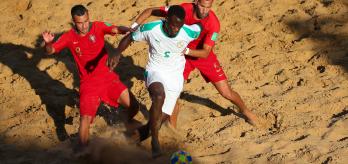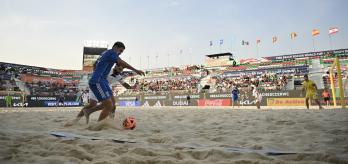Teams have commenced the competition demonstrating some strong and interesting strategic approaches and it is evident that a lot of preparatory work has been done by the competing nations. A tactical approach used by Spain in their opening Group B match against Iran grabbed the attention of our Technical Study Group (TSG) and here, Matteo Marrucci explains why:
“In this game, we saw something new. Normally in beach soccer offensive play, teams always operate with at least one attacking player who occupies zone 4 (the opponent’s penalty area), but at certain times against Iran, Spain did not do this and used an adaptation of the 1-4-0 set-up that we often see in futsal. When they switched to this tactic in the game, the instruction clearly came from the head coach, Christian Méndez, and it was very interesting to see because their movements and intentions were well orchestrated and had clearly been worked on prior to the tournament.”
Usually in beach soccer, teams use variations of the following systems: 1-3-1; 1-2-2 (or 1-2-1-1 variant) – so Spain’s use of the 1-4-0 was novel. It is a difficult system to implement according to Marrucci.
“In futsal teams play 1-4-0 but the surface in flat so the game is faster. As a beach soccer coach, I have considered this system, but it is not straightforward to implement, and Spain’s adaptation caused real difficulties for Iran’s defenders because they had not faced it before. Their defenders were being dragged into parts of the pitch that they are not used to being and Spain’s rotations really disrupted Iran’s defending. It was also notable that this strategy was often deployed when Chiky (11) was on the pitch,” he explained.
Spain’s 1-4-0 approach
When using this strategy, Spain purposely opened and cleared space in zone 4. They did this by getting their forward players, who started in the area, to make deliberate runs into deeper and wide areas, dragging their defenders with them. Spain’s players rotated this responsibility, in a deviation from their normal roles, meaning players were operating in parts of the pitch that they were not expected to be.
Using Clip 1 below, Dejan Stanković explains the intent that appeared to underpin Spain’s movement:
“We clearly see Spain’s intention to clear the space in zone 4 as they build-up their play. The wide and deep position (in zone 3) that is taken up by Chiky is deliberate and is designed to occupy Iran’s right-sided defender and to tempt him away from his defensive zone. It is very unusual to see no attacking players in the penalty area (zone 4) when the player in possession of the ball, Ardil (5), is so advanced and Chiky’s movement to this position is not designed for him to receive the ball, it’s intended to clear space.
“Spain’s intentions to clear the central space are further evident when we see the diagonal run that Oliver (3) makes. In making this movement, he drags a defender with him and opens the central space as Chiky holds his position wide on the left. This gap provides the opportunity for Cabrera (7) to make a dangerous forward run from deep. While it does not work perfectly in this example, we can see how Spain are very deliberate in their rotations and movement off the ball, in order to create the space they want to attack, and in their intentions to move the opposition defenders away from the penalty area,” he explained.
In Clip 2, when Spain goalkeeper Dona (1) has the ball, we see similar movement patterns that are designed to open space in zone 4 and disrupt opposition defenders as Stanković explains.
“Again, we see the movement of Chiky from zone 4 into a wider, deeper part of the pitch where he receives the ball under the attention of two defenders. This movement drags the second defender and clears the space for the run of Ardil from deep, while it also frees up Arias (4) on the right-hand side. This leaves Spain with a potential 2v1 on the only centrally located defender. As the play develops, Iran’s defenders are disrupted as they re-adjust to the positioning of Spain’s attacking players and Ardil has time to tee himself up for a well-executed overhead-kick finish.”
Summary
Spain’s movement and rotations allowed their players to deviate from their positional norms and in so doing, they posed interesting problems for their opponent to solve. When in this offensive 1-4-0 phase, and operating with no clear striker, Spain’s players dragged opposition defenders into parts of the pitch they would not usually expect to be, forcing them to decide whether to track their player or defend the zone. Spain’s subsequent attacking runs into zone 4 from players in deeper positions, dragged opposition forward players into defensive areas. This was an intriguing feature of Spain’s offensive play.









